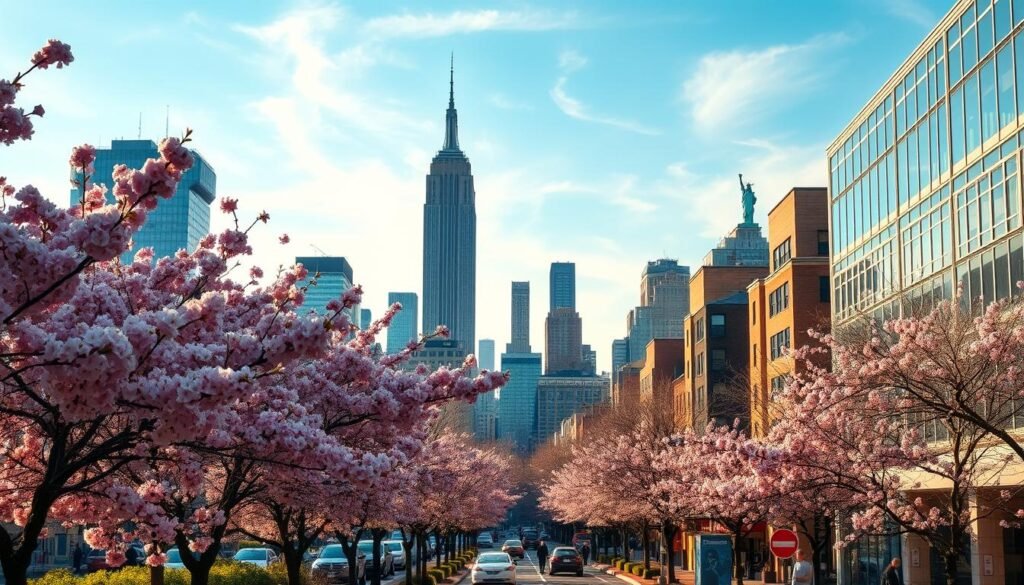Surprising fact: more than 50 million people come through the city each year, so picking when I go shapes every part of the trip—from weather and crowds to prices and events.
I weigh options based on what I want: gentle weather for walking, lively outdoor festivals, festive holiday scenes, or wallet-friendly deals. Spring and fall lure me for blossoms and foliage while crowds thin and parks look great.
Winter often means savings and hotel promos like NYC Hotel Week and twice-yearly Restaurant Week. Summer brings free park shows and street energy, though I plan indoor breaks for heat and humidity.
I share which months pack the biggest events and when shoulder seasons give the best mix of comfort and availability. For a deeper calendar and festival notes, see this seasonal timing guide.
Key Takeaways
- Spring and fall offer mild temps and thinner crowds—ideal for walking and parks.
- High-demand windows raise prices and attendance in summer and the holiday stretch.
- January–March is the low season for the biggest savings on lodging and tours.
- Major events cluster in summer and autumn; plan early if an event is a priority.
- Shoulder months often balance weather, crowds, and availability for smarter travel.
How I Weigh Seasons in New York City: Weather, Crowds, and Vibes
My planning kicks off with the weather — it shapes nearly every part of a trip. I check average temperatures and humidity so I know if I’ll need a light jacket, layers, or heavy winter gear. That helps me plan walking routes and decide how many outdoor things I schedule each day.
Next I factor in crowds and prices. High season runs late May through early September and again in November–December, which means heavier foot traffic and higher hotel rates. Shoulder months—April to mid-May and mid-September to October—offer milder weather and quieter streets, so I can walk more and spend less time hunting for tables or tickets.
- Energy: I match the vibe I want—spring buzz, summer nights, fall festivals, or winter museums.
- Deals: I pencil in January–March for lower rates and promotions like Restaurant Week.
- Comfort: I check commute and platform conditions so heat or wind won’t ruin long walking days.
Finally, I weigh signature moments—Pride, marathons, holiday lights—against my tolerance for crowds and plan my dates around that balance of events and calm. That process makes choosing the right season and exact time feel less random and more like a fit for what I want from the city.
The best time to visit new york for your trip goals
![]()
I choose dates by what I want to do—easy walks, blossom hunts, bargain stays, or free outdoor nights. That focus helps me match weather, crowds, and activities to my energy and budget.
For perfect walking weather and fewer tourists: late September to early November
In fall the air turns crisp and crowds thin after summer. I can stroll neighborhoods and linger in parks with clearer skies and comfortable weather.You can see best-hawaiian-island-to-visit
For blooms and mild temps on a budget: April to mid-May
Spring brings cherry blossoms at Central Park and Brooklyn Botanic Garden. I pack a light jacket and an umbrella for brief showers and plan morning outings to avoid any lingering crowds.
For the cheapest hotel prices and 2-for-1 deals: January to March
Winter is low season for prices. I use NYC Hotel Week, Broadway Week 2-for-1 offers, and Restaurant Week to stretch my hotel and show budget while indoor activities keep me warm.
For free outdoor events and park nights: June to August
Summer fills parks with free programming like SummerStage and Bryant Park performances. I build late-day plans around cooler spots and quick indoor breaks to beat humidity and still enjoy nights outdoors.
- Strolls & Crowds: Late fall and early spring let me linger outdoors without shoulder-to-shoulder lines.
- Deals & Prices: Winter gives the biggest hotel and show savings.
- Parks & Activities: Summer offers the richest free-program lineup for nights under the sky.
New York City by Month: What I Expect from January through December
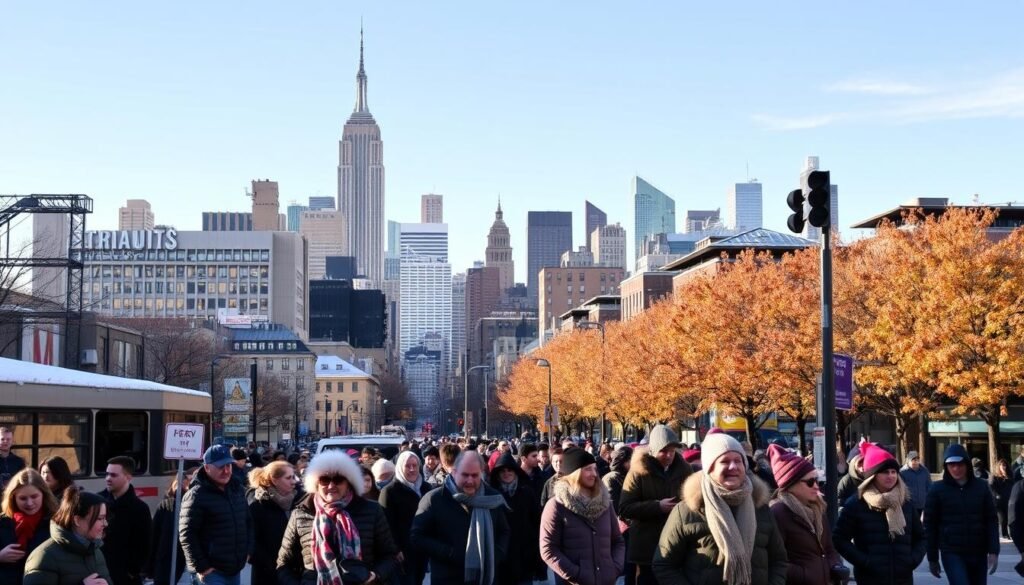
Each month in the city brings its own weather patterns, crowds, and headline events that shape my plans. Below I run through quick notes on temperatures, deals, and marquee happenings so I can pick the best days for what I want to do.
January: Rock-bottom hotel prices, Broadway Week offers 2-for-1 seats, and deep cold means museums and food halls fill my days.
February: Fashion Week and Lunar New Year parades energize indoor festivals and cozy dining.
March: Wintry mixes can linger; I plan layers for St. Patrick’s Day and swing by the Macy’s Flower Show for color.
April–June
April bursts with cherry blossoms; May brings mild temperatures, outdoor dining, and Fleet Week. June starts Tribeca, Pride, and SummerStage concerts.You can see best-time-to-visit-bali
July–September
July brings heat and fireworks; I build in AC breaks. August offers beach escapes and the US Open with late-month hotel dips. September is my shoulder-season sweet spot as Broadway returns and festivals fill streets.
October–December
October has peak foliage and major film and comic events. November cools fast with the marathon and Thanksgiving parade. December is all holiday markets, the Rockefeller Center tree, and New Year’s Eve choices.
Crowds and Prices Through the Year: When I Find Deals vs. Peak Times
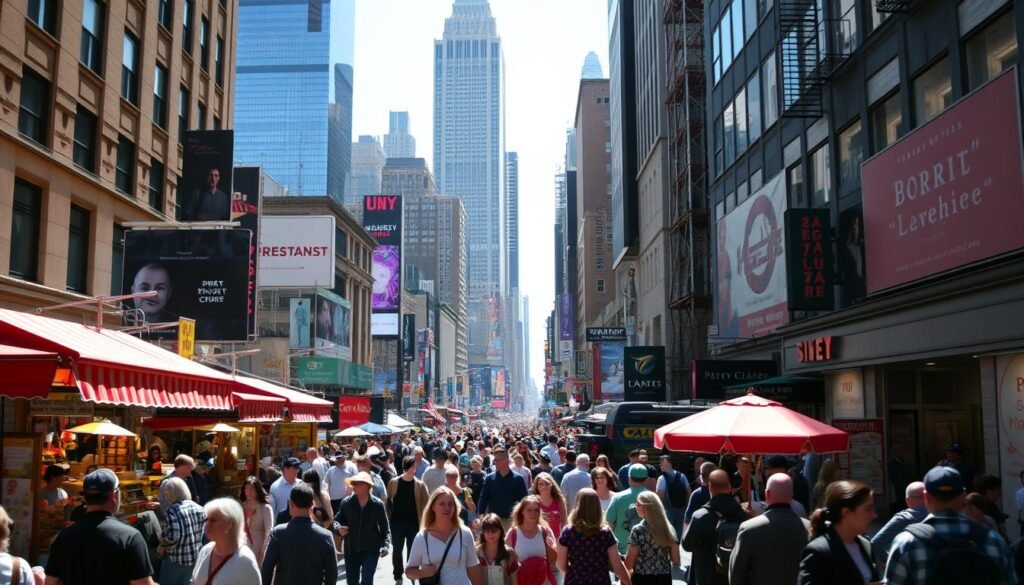
I track how demand curves shift through the year so I know when streets fill and when deals appear.
High-season windows—late May through early September and November through December—bring heavy crowds and higher prices. I expect busier sidewalks, crowded attractions, and firm hotel rates then.
Shoulder months (April–mid-May and mid-September–October) give me quieter streets and milder weather. I use these stretches when I want shorter lines and nicer park days without freezing temperatures.
Low season runs January–March. I aim here for the biggest savings on hotels and airfare. I also book Restaurant Week and NYC Hotel Week offers to stretch my budget further.
- I price-shop early for summer and hunt late‑August dips if my dates are fixed.
- I favor midweek stays and flexible cancellation for lower rates in busy months.
- Families: I lean to early June or end of August for better balance of availability and activity.
- I check neighborhoods—midtown holds peak rates while outer-borough bases can save money.
Seasonal Weather Snapshot: What I Pack for Each Time of Year
![]()
Packing for a trip here means planning for sudden shifts in weather and pace across boroughs. I think about micro-climates, transit crowds, and the mix of outdoor and indoor activities I want.
Spring: I pack light layers, a compact umbrella, and comfortable shoes. Cherry blossoms arrive late March–April, so I plan morning walks and a quick cafe break if showers roll in.
Summer: I choose breathable fabrics, sunscreen, and a refillable water bottle. Heat and humidity make midday AC breaks in museums or food halls a must, and subway platforms can feel much hotter than street level.
Fall: A light jacket and a daypack for camera gear are staples. Foliage peaks mid-October to early November, so I schedule golden-hour park loops for photos and long walks.
Winter: I bring insulated boots, warm socks, hat, and gloves for wind and slush. Cold snaps and snowstorms from January through March send me indoors for matinees and gallery afternoons.You can see best-island-to-visit-in-hawaii
I also keep a portable charger and a transit-friendly tote so I can hop from parks to galleries with essentials. I always pack one smart casual outfit for shows or dinners, since evenings in New York often call for a little polish.
Events and Festivals I Plan Around
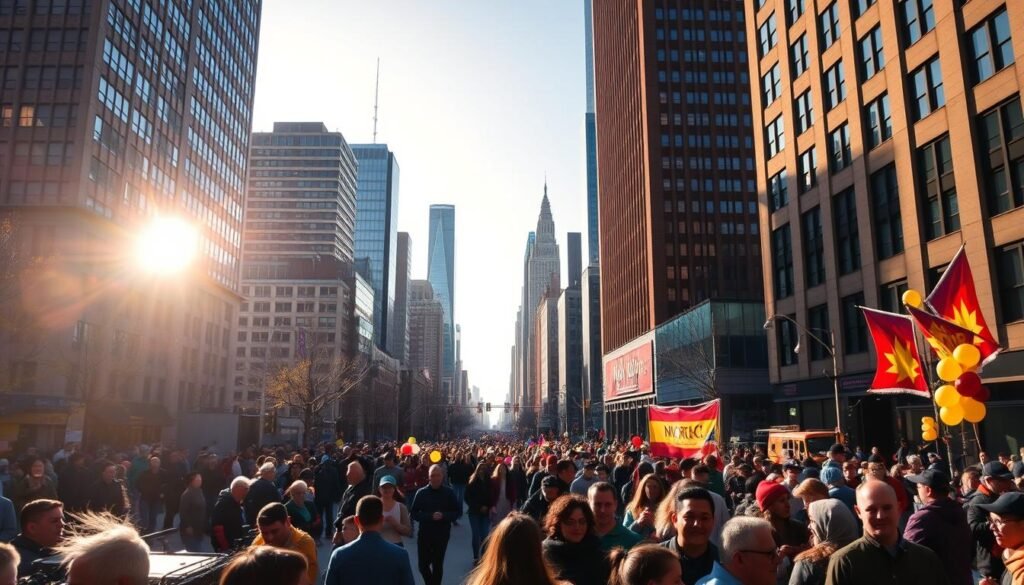
I plan trips around a handful of marquee events that shape the city’s calendar. These celebrations set the rhythm for each season and help me build days that mix big moments with quieter spots.
Spring highlights
I circle cherry blossom weeks for photo walks and layer outdoor meals as outdoor dining ramps up.
I also add design and food festivals to sample whole neighborhoods in one go.
Summer standouts
Summer is packed: I anchor my plans with Pride and the Coney Island Mermaid Parade, then book early for Shakespeare in the Park and SummerStage nights.
Fall favorites
In autumn I chase culture—NY Film Festival screenings, Open House access to landmark buildings, and the Feast of San Gennaro for classic street-fair energy.
Winter biggies
Winter brings Fashion Week, Restaurant Week promotions, and Lunar New Year parades that light up several Chinatowns.
“I build itineraries that pair marquee events with nearby museums, parks, or cafes so each day blends big moments and laid-back local time.”
- I plan arrival strategies for free shows, lining up early or entering digital lotteries when offered.
- I check venue maps and transit routes so I can hop across Manhattan, Brooklyn, and Queens in one day.
- I leave buffer time for pop-up galleries, street performers, and neighborhood festivals I discover on foot.
| Season | Key events | What I pack | Notes |
|---|---|---|---|
| Spring | Cherry blossoms, food & design fests | Light layers, umbrella | Book outdoor dining reservations |
| Summer | Pride, Mermaid Parade, SummerStage | Breathable clothes, water bottle | Arrive early for free shows |
| Fall | Film Festival, Open House, Feast | Light jacket, camera | Plan cultural blocks by neighborhood |
| Winter | Fashion Week, Restaurant Week, Lunar New Year | Warm layers, insulated boots | Use indoor museum time as fallback |
For an updated October lineup and other monthly listings, I check a local events calendar like October events calendar before I finalize dates.
Holiday Season in NYC: Lights, Skates, and Peak Festivity
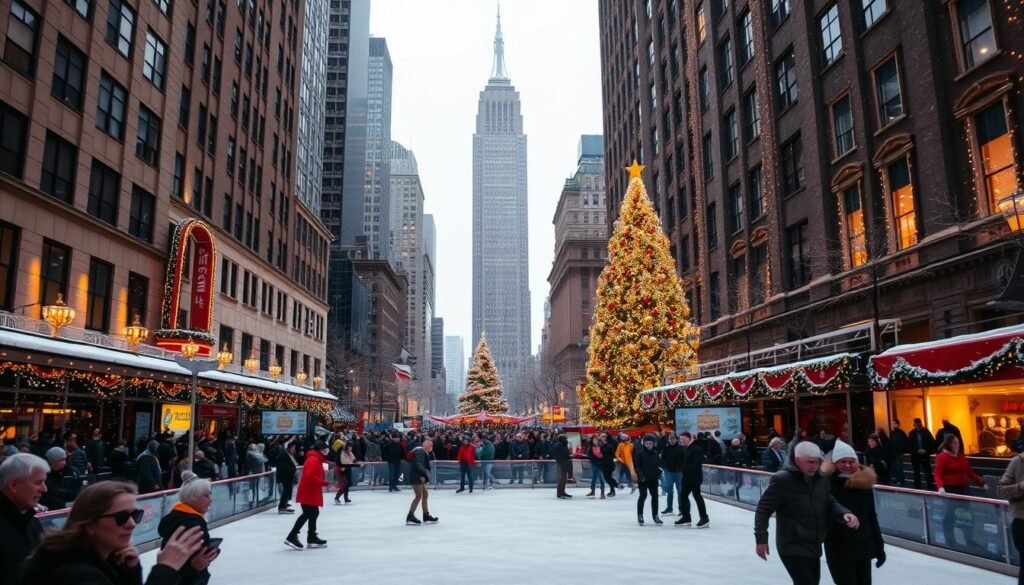
Holiday lights change how the city feels, so I plan evenings around glowing windows and open-air markets. I map short walking loops that mix big moments with cozy stops so I can soak in displays without burning out.
Rockefeller Center tree, Fifth Avenue windows, and holiday markets
I start at the Rockefeller Center tree early in the morning, then wander Fifth Avenue’s window displays before crowds swell. Major markets like Bryant Park Winter Village and Union Square offer gifts and hot chocolate.
Ice skating rinks, Radio City Rockettes, and cozy neighborhoods
I book skating slots and Rockettes seats well ahead. Rinks operate across boroughs, and the Christmas Spectacular fills fast during the holiday season. Evenings in decorated neighborhoods feel intimate; I duck into bakeries or bars to warm up.
What I consider for New Year’s Eve in Times Square
New Year’s Eve in Times Square draws massive lines and strict security. I weigh long waits and no re-entry before I commit. If I skip that spectacle, I choose neighborhood dinners, rooftop fireworks, or transit-ready viewing spots for a quieter new year moment.
“I pair paid attractions with free lights and markets, hunt midweek stays, and layer up with a thermos and quick museum stops so long outdoor stretches stay comfortable.”
- I plan early morning runs at icons to see more with fewer people.
- I mix a paid attraction with lots of free lights to balance cost when late November–December rates rival summer.
- I secure transit and entry plans before the night so I can enjoy the festival pace when I visit New York.
Parks, Neighborhoods, and Iconic Backdrops by Season
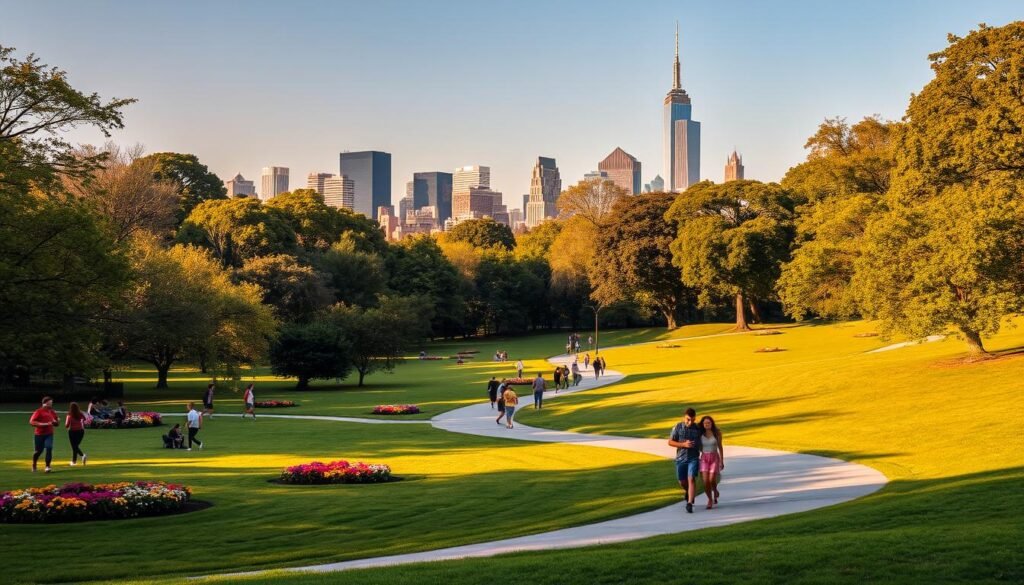
I plan neighborhood loops that pair leafy parks with iconic backdrops for each season. I choose routes that match light, events, and how I want a day to feel in New York.
Central Park: spring blossoms and fall color
I map seasonal photo walks through Central Park, starting at the Reservoir and Pilgrim Hill in spring for cherry blooms. In mid-October to early November I chase fiery foliage in the Ramble and along the Mall.
Tip: Early mornings give quieter paths and cleaner light for photos and peaceful park time.
City parks in summer: evening programs and island breezes
Summer brings Bryant Park film nights and Picnic Performances that feel free and lively. I often hop the ferry to Governors Island for cooler breezes and skyline views on long weekend afternoons.
I weave low-key parks into plans too—Prospect Park, Brooklyn Bridge Park, and Fort Tryon are great for calm moments between attractions and museums.
Neighborhood flavor shifts: fall street style and summer boardwalks
I match neighborhoods to the season. SoHo shines with soft fall light and fashion energy for street photography. Coney Island wakes up in summer with the Mermaid Parade, rides, and beach days that make classic city things feel like a seaside escape.
I time my days around light and events, combine activities like picnics before museum openings, and always end with a seasonal treat—gelato in summer, apple cider in fall—to cap the day right.
“Pair parks and neighborhoods by season so each walk shows a different side of the city.”
Conclusion
My final pick balances weather, crowds, and events so each day feels intentional. I lean toward late September–early November for ideal light, mild temperatures, and fewer tourists. That stretch gives me the most enjoyable walks and festival variety without packed lines.
For other goals: April–mid‑May fits bloom hunters and those watching prices. January–March is where I stretch a hotel and show budget with big savings and promotions.
I build each trip around months, neighborhoods, and a mix of free parks and paid attractions. Book popular dates early, plan cool‑of‑day breaks in summer heat, and leave room for small discoveries. That approach keeps travel flexible and rewarding all year.


